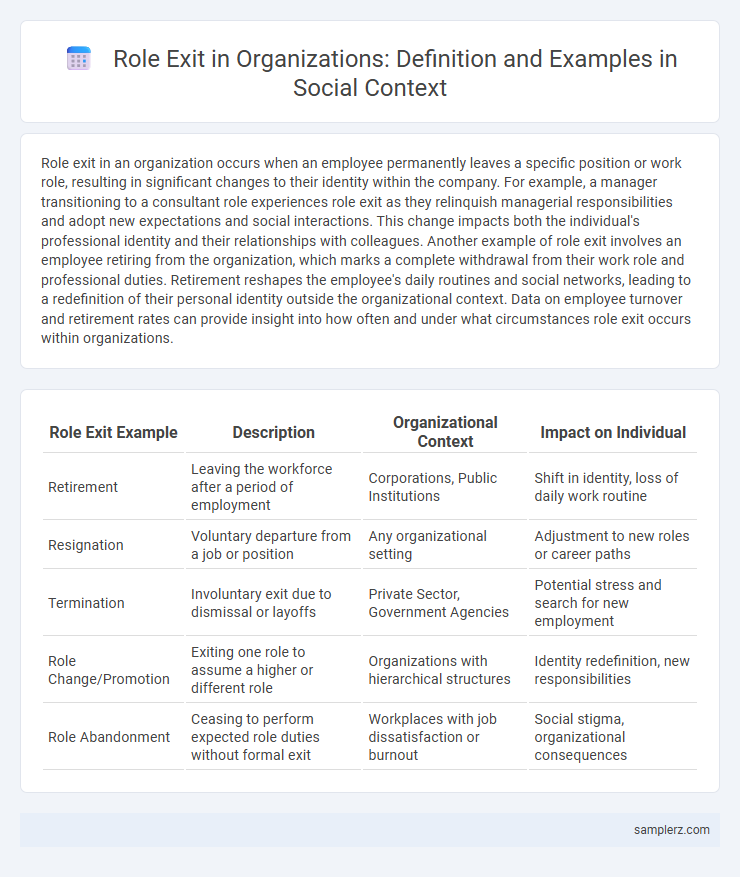Role exit in an organization occurs when an employee permanently leaves a specific position or work role, resulting in significant changes to their identity within the company. For example, a manager transitioning to a consultant role experiences role exit as they relinquish managerial responsibilities and adopt new expectations and social interactions. This change impacts both the individual's professional identity and their relationships with colleagues. Another example of role exit involves an employee retiring from the organization, which marks a complete withdrawal from their work role and professional duties. Retirement reshapes the employee's daily routines and social networks, leading to a redefinition of their personal identity outside the organizational context. Data on employee turnover and retirement rates can provide insight into how often and under what circumstances role exit occurs within organizations.
Table of Comparison
| Role Exit Example | Description | Organizational Context | Impact on Individual |
|---|---|---|---|
| Retirement | Leaving the workforce after a period of employment | Corporations, Public Institutions | Shift in identity, loss of daily work routine |
| Resignation | Voluntary departure from a job or position | Any organizational setting | Adjustment to new roles or career paths |
| Termination | Involuntary exit due to dismissal or layoffs | Private Sector, Government Agencies | Potential stress and search for new employment |
| Role Change/Promotion | Exiting one role to assume a higher or different role | Organizations with hierarchical structures | Identity redefinition, new responsibilities |
| Role Abandonment | Ceasing to perform expected role duties without formal exit | Workplaces with job dissatisfaction or burnout | Social stigma, organizational consequences |
Understanding Role Exit in Organizations
Role exit in organizations occurs when employees disengage from their current positions to assume new roles, whether through promotion, retirement, or career change. This process involves psychological detachment from previous responsibilities and adaptation to new expectations, impacting both individual identity and organizational dynamics. Understanding role exit helps organizations manage transitions smoothly, reduce turnover disruption, and support employee development effectively.
Key Factors Leading to Role Exit
Role exit in organizations often results from key factors such as burnout, job dissatisfaction, and shifting personal values that no longer align with organizational goals. Workplace conflict, lack of career advancement opportunities, and changes in life circumstances like family responsibilities also contribute significantly to employees' decisions to leave their roles. These factors collectively drive the disengagement process, prompting individuals to seek alternative identities outside their current organizational roles.
Classic Examples of Role Exit at Work
Classic examples of role exit in organizations include employees transitioning from managerial to non-managerial positions, often due to restructuring or personal choice. Another common scenario is retirement, marking a formal departure from professional roles and responsibilities. Role exit also occurs when individuals leave a vocational role to pursue different careers, reflecting significant identity and social role changes within the workplace.
Signs an Employee Is Preparing for Role Exit
Signs an employee is preparing for role exit often include decreased engagement in meetings, reduced responsiveness to emails, and a noticeable decline in productivity. They may begin disengaging from long-term projects and show less interest in organizational goals or social interactions with colleagues. Observable behaviors such as updating resumes on professional networks or increased requests for references also signal imminent role exit.
The Impact of Role Exit on Team Dynamics
Role exit in organizations, such as when a team leader resigns or is promoted, significantly disrupts established team dynamics by altering communication patterns and decision-making processes. The departure of a key member often leads to role ambiguity, decreased morale, and temporary productivity loss as teams adjust to new leadership or redistributed responsibilities. Understanding the psychological and social impact of role exit helps organizations implement strategies that maintain cohesion and minimize turnover consequences.
How Leaders Facilitate Smooth Role Exits
Leaders facilitate smooth role exits by implementing clear transition plans and providing comprehensive knowledge transfer protocols, ensuring continuity and minimizing disruption. They actively engage in open communication with outgoing members to address emotional and practical challenges, fostering a supportive environment. Leveraging mentorship programs and phased handovers, organizations maintain operational stability while empowering successors for seamless integration.
Role Exit vs. Role Transition: Organizational Differences
Role exit in organizations occurs when an employee permanently leaves a professional identity, such as retiring from a managerial position, marking a clear separation from their previous role. Role transition involves shifting responsibilities within the organization without relinquishing the professional identity, like a promotion from analyst to team lead. Understanding these differences helps organizations manage employee identity changes and reduce role ambiguity during structural adjustments.
Emotional Challenges During Role Exit
Role exit in organizations often involves intense emotional challenges such as loss of identity, anxiety about the future, and grief over leaving familiar social networks. Employees may experience uncertainty and decreased self-esteem as they detach from established roles and relationships. Coping mechanisms like seeking social support and reframing personal narratives are crucial for managing the psychological impact of role transitions.
Supporting Employees Through Role Exit Processes
Supporting employees through role exit processes involves providing clear communication, counseling services, and career transition resources to ease the shift from one organizational role to another. Organizations implementing structured exit interviews and mentorship programs help employees reflect on their experiences while preparing for future opportunities. This approach reduces anxiety, maintains morale, and preserves positive employer-employee relationships during times of change.
Case Studies: Successful Role Exits in Modern Organizations
Case studies of successful role exits in modern organizations highlight the strategic transition of leaders such as Satya Nadella at Microsoft, who seamlessly shifted from CEO to a senior advisor role, ensuring organizational continuity and innovation. Another example is Sheryl Sandberg's departure from Meta as COO, where her defined exit plan and mentorship programs facilitated a smooth succession and sustained corporate culture. These cases underscore the importance of structured role exit frameworks in maintaining stability and preserving institutional knowledge during leadership changes.

example of role exit in organization Infographic
 samplerz.com
samplerz.com